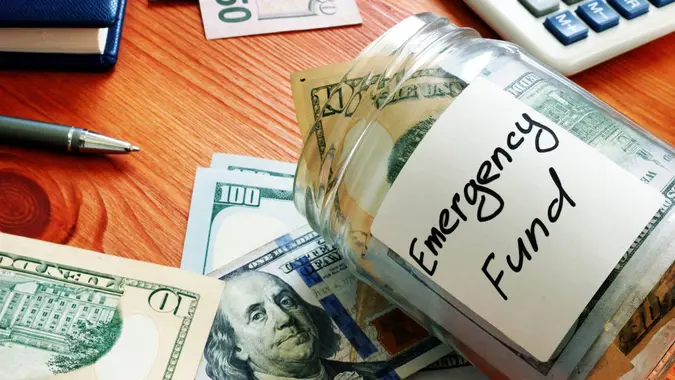I Asked AI Where To Shift My Savings To Make Extra Interest Income — Here’s What It Said

Commitment to Our Readers
GOBankingRates' editorial team is committed to bringing you unbiased reviews and information. We use data-driven methodologies to evaluate financial products and services - our reviews and ratings are not influenced by advertisers. You can read more about our editorial guidelines and our products and services review methodology.

20 Years
Helping You Live Richer

Reviewed
by Experts

Trusted by
Millions of Readers
Interest rates are on the move again, so it’s a good time to look at where your money is and how hard it’s working for you. To find out where the best place is to put your money to earn the most interest, I asked ChatGPT. The question posed was: “Where can I put my savings to earn extra interest income?” Below is what the chatbot had to say.
Also here are the best ChatGPTs for investors.
Things To Consider
The first thing ChatGPT said was to analyze your needs, which is good advice. “The best place to put your savings depends on how soon you’ll need the money, your risk tolerance and whether you want it to be liquid (easy to access),” ChatGPT wrote.
The Safest Options
ChatGPT went on to list several options for higher-interest savings, in order from the safest and most liquid to the riskiest.
For the safest options, these were the suggestions.
- High-Yield Savings Accounts (HYSAs):
Online banks like Ally, Marcus or Discover currently offer 4% to 5% APY. Fully liquid and safe. - Money Market Accounts:
Similar to HYSAs, sometimes with check-writing privileges. Rates around 4% to 5% APY. - Certificates of Deposit (CDs):
Lock money for a term (six months to five years) at a guaranteed rate. Current CD rates can be 5% or more. Best if you won’t need the funds before maturity. - Treasury Bills (T-Bills):
U.S. government bonds, sold in four- to 52-week terms. Safe and currently yielding about 5%. You can buy directly at TreasuryDirect.gov.
ChatGPT noted that all of these options are FDIC or NCUA insured, which is not technically true. Treasury bills are not FDIC-insured, but they are backed by the full faith and credit of the U.S. government. Practically speaking, that’s the same thing as the government backs the FDIC as well, but it’s worth noting that treasuries are an investment, not a deposit.
Savings Options With More Risk and Higher Yield
ChatGPT explained that these options offer higher interest than the safer options mentioned, but may earn more interest. The bot notes that these are good options if you have a longer time horizon, i.e., you won’t need the cash soon.
- Bond ETFs or Mutual Funds:
Short-term Treasury or corporate bond funds can yield 4% to 6% but prices may fluctuate. - Dividend-Paying Stocks / ETFs:
Can provide 2% to 5% dividends plus growth, but stock prices are volatile. - REITs (Real Estate Investment Trusts):
Often yield 5% to 8% in dividends, but riskier and sensitive to interest rate changes.
These are, in fact, riskier options and may not be appropriate for what most people would likely consider “savings.” The point about not needing the money soon is well taken — these are not as liquid as the safer options previously mentioned.
Options for More Growth Over the Long Term
ChatGPT noted that these options are not really savings, but worth considering if you won’t need the money for 5 or more years. This is an important caveat, but it begs the question of why they are included in suggested investments for savings.
- Stock Index Funds (like S&P 500 ETFs):
Historically average 7% to 10% annually over long periods. - Target-Date Retirement Funds:
Automatic diversification with both stocks and bonds, based on your timeline.
ChatGPT offers this quick rule of thumb for a savings timeline:
- Money you need in the next one to three years: HYSAs, CDs or T-Bills
- Money for three to 10 years: bond funds, REITs or conservative ETFs
- Money for 10 or more years: stock index funds
A Step-By-Step Savings Plan
ChatGPT then offered to break down this advice into a plan. Here’s what it came up with.
Step 1: Define Your Time Horizons
Think about when you’ll need the money:
- Short-term (zero to three years): Emergency fund, car purchase, home down payment.
- Medium-term (three to 10 years): Bigger goals like starting a business, upgrading a home.
- Long-term (10+ years): Retirement, financial independence, legacy.
Step 2: Allocate Savings by Timeline
Short-term (safe and liquid — 40% to 60% of savings):
- Where:
- High-Yield Savings Account (HYSA): about 4% to 5% APY
- Three to 12 month CDs or T-Bills: about 5% guaranteed
- Purpose: This is your emergency fund (three to six months of living expenses) plus any money you’ll need soon.
Medium-term (moderate risk — 20% to 30% of savings):
- Where:
- Bond ETFs (short-term Treasuries/corporates): 4% to 6% yield, some price fluctuation
- Dividend ETFs or REITs: 3% to 6% income, plus growth potential
- Purpose: Grow money faster than savings accounts, but still less risk than stocks.
Long-term (Growth — 20% to 40% of savings):
- Where:
- S&P 500 Index Fund or Total Stock Market ETF: 7% to 10% historical average
- Target-Date Retirement Fund (if saving for retirement): Balanced mix of stocks & bonds that adjusts automatically
- Purpose: Build wealth for retirement and financial independence.
Step 3: Example Allocation for $50,000 in Savings
- $25,000 (50%): HYSA and T-Bills/CDs (liquid and safe)
- $12,500 (25%): Bond ETF and Dividend ETF (income-producing)
- $12,500 (25%): S&P 500 Index Fund (long-term growth)
Step 4: Automate and Rebalance
- Automate transfers: Move extra cash into HYSA or investments each month.
- Rebalance yearly: Adjust percentages back to your targets.
- Increase long-term allocation as your emergency fund is fully funded.
How ChatGPT’s Recommendations Stack Up
The information ChatGPT gave about savings options is good, although its definition of “savings” is pretty broad, as it includes investments and other long-term options. The allocation example is pretty generic, without much explanation of the saver’s goals or timeline.
Savings Trends
Research by JP Morgan Chase indicates that household balances in checking and savings accounts remain low, but total cash reserves are growing. Since ‘total cash reserves’ include CDs, brokerage accounts, etc., this finding would indicate that households are shifting their cash out of checking and savings accounts that historically pay low or no interest, into higher-interest-paying accounts.
According to the report, lower-income households are seeing the most relative growth in their cash balances.
Be Consistent
With interest rates in flux, it’s important to keep an eye on your savings. Shifting to the highest-paying safe account you can find is often the best advice, particularly if it’s money you may need in a hurry. But the most important thing about savings is to make sure you’re adding to it consistently so you’ll have that extra cushion when you need it.
More From GOBankingRates
- Nearly 1 in 3 Americans Hit by a Costly Holiday Scam, Norton Survey Shows -- How To Avoid This
- Here's What the Average Social Security Payment Will Be in Winter 2025
- How Middle-Class Earners Are Quietly Becoming Millionaires -- and How You Can, Too
- The Easiest Way to Score $250 for Things You Already Do
 Written by
Written by  Edited by
Edited by 

























